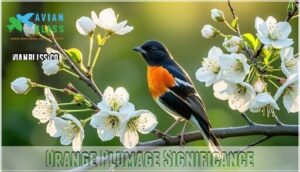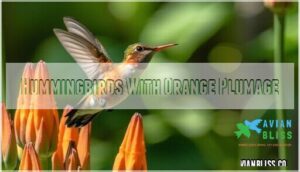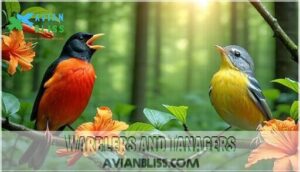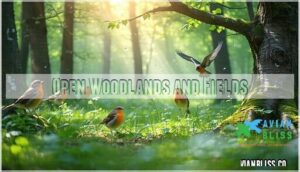This site is supported by our readers. We may earn a commission, at no cost to you, if you purchase through links.
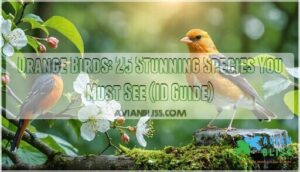 You’ll find orange birds in backyards, woodlands, and wetlands across North America.
You’ll find orange birds in backyards, woodlands, and wetlands across North America.
These striking species include Baltimore Orioles with their vibrant orange bodies, American Robins sporting orange-red breasts, and Flame-colored Tanagers showing off brilliant plumage.
Their orange coloring isn’t just for show—it plays essential roles in attracting mates and defending territory.
From tiny hummingbirds to large orioles, these birds adapt to diverse habitats, visiting feeders and nesting in trees.
Some migrate thousands of miles, while others stay year-round.
The intensity of their orange varies by species, age, and season, creating a fascinating spectrum of colors that’ll make your birdwatching adventures unforgettable.
Table Of Contents
- Key Takeaways
- Orange Birds Overview
- Orange Plumage Significance
- Orange Bird Species
- Habitat Preferences
- Rare Orange Bird Species
- Frequently Asked Questions (FAQs)
- What is orange birds of North America?
- What birds have orange plumage?
- How many types of Orange birds are there?
- What is a small orange bird?
- What do Orange birds look like?
- Can you identify an orange bird in your backyard?
- What kind of bird is orange in color?
- What type of bird likes oranges?
- Where do orange orioles live?
- What bird is orange in color?
- Conclusion
Key Takeaways
- You’ll spot 25+ orange bird species across North America, from common American Robins with orange breasts to brilliant Baltimore Orioles with black and orange patterns
- Orange plumage isn’t just decorative—it’s crucial for attracting mates and defending territory, with colors intensifying during breeding season
- You can attract these birds to your yard using nectar feeders, orange fruit halves, grape jelly, and shallow birdbaths near feeding stations
- These birds inhabit diverse environments from dense woodlands and wetlands to suburban backyards, with some migrating thousands of miles while others stay year-round
Orange Birds Overview
You’ll discover 25 spectacular orange birds across North America, from the brilliant Baltimore Oriole to the tiny Rufous Hummingbird.
These vibrant species showcase remarkable diversity in their migration patterns, spanning from year-round residents like the American Robin to long-distance travelers that journey thousands of miles between breeding and wintering grounds, which is a testament to their diversity.
North American Species
You’ll find North America’s orange birds across diverse habitats, from backyard feeders to dense woodlands.
Robin Behavior includes ground foraging, while Wren Diet consists mainly of insects.
These species showcase remarkable adaptability and striking plumage patterns.
- Baltimore Oriole – Eastern songbird with brilliant orange and black coloring
- Bullocks Oriole – Western counterpart with distinctive white wing patches
- American Robin – Common thrush with orange breast and melodic songs
- Red-breasted Nuthatch – Compact climber with orange underparts and nasal calls
Migration Patterns
You’ll witness incredible journeys as orange birds set out on epic migrations spanning thousands of miles.
These feathered travelers respond to daylight reduction and seasonal changes as migration triggers, with most beginning their southward trek between late July and early September.
| Migration Aspect | Details |
|---|---|
| Distance Traveled | Orioles fly 800+ km nonstop across Gulf of Mexico |
| Seasonal Changes | Peak movement occurs September 10th-30th |
| Stopover Sites | Riparian habitats with abundant fruit sources |
Climate impact substantially affects bird migration timing, with drought conditions shifting departure dates by up to two weeks.
Orange birds demonstrate remarkable navigation skills, using both celestial cues and magnetic sensing during nighttime flights along major bird migration routes like the Mississippi and Atlantic Flyways.
Geographic Distribution
Where do orange birds call home? These vibrant species span continents with fascinating Regional Variations across North America, Europe, Asia, and Africa.
North American orange birds show distinct Migration Routes, while Climate Impact affects bird ranges globally.
You’ll discover Habitat Overlap between species like orioles and tanagers. Some Introduced Species have expanded their bird distribution beyond native territories.
Understanding bird geography helps identify these stunning creatures across diverse ecosystems worldwide. Many are found in Michigan, including the brightest orange birds.
Orange Plumage Significance
Orange plumage serves as a powerful visual signal in birds, helping them attract mates and establish territory boundaries during breeding season.
Bright orange feathers are nature’s way of saying "look at me" during mating season.
You’ll notice that many orange birds develop their brightest coloration when they’re ready to reproduce, making these vibrant hues essential for their survival and genetic success.
Unique Tail Structure
You’ll notice remarkable diversity in tail feather shape among orange birds.
American Redstarts flash fan-shaped tails with distinctive orange patches, while Baltimore Orioles sport longer, more pointed tail formations.
Tail length variation creates unique silhouettes – from the stubby tails of nuthatches to the elongated features of orioles.
These tail markings and functionality serve essential purposes in flight control and species identification during your birdwatching adventures.
Habitat Adaptation Patterns
Bird habitats shape how orange species survive across diverse environments.
Climate influence drives birds like Baltimore Orioles to seek warmer regions, while predator avoidance pushes American Robins into suburban areas.
Human impact creates new nesting strategies—Bullock’s Orioles now build near homes for protection.
Food sources determine settlement patterns, with hummingbirds following flower blooms.
These bird adaptation patterns showcase remarkable bird ecology responses to environmental pressures, highlighting the importance of environmental pressures.
Bright Orange Underbellies
Spotting bright orange underbellies reveals nature’s masterpiece of bird identification.
These vibrant displays serve dual purposes: attracting mates and signaling health status.
Diet influence shapes intensity—carotenoid-rich foods create deeper hues.
Gender differences appear striking in oriole species and tanager species, with males showcasing bolder patterns.
Juvenile plumage often lacks this brilliance until maturity.
Bird color variations help distinguish similar species through these distinctive bird plumage patterns, which are a key part of bird identification and showcase nature’s masterpiece.
Orange Bird Species
You’ll discover that orange birds come in three main groups: orioles with their vibrant black and orange patterns, hummingbirds sporting brilliant rufous plumage, and warblers plus tanagers that flash orange throats and underparts.
Each group offers distinct identification features that make spotting these colorful species both rewarding and straightforward, with complete concepts like vibrant patterns and brilliant plumage.
Orioles and Their Characteristics
Orioles rank among the most recognizable songbirds you’ll encounter during birdwatching adventures.
These vibrant species showcase remarkable diversity in their characteristics and behaviors.
Key oriole features include:
- Nest Construction: Woven hanging pouches crafted from plant fibers and grasses
- Song Complexity: Rich, flute-like melodies that vary substantially between oriole species
- Plumage Variation: Males display brilliant orange and black patterns while females show subtler coloring
Baltimore Orioles dominate eastern regions with their striking orange heads and black wings.
Bullock’s Orioles claim western territories, featuring orange chests and distinctive white wing patches.
Orchard Orioles present rusty orange underparts with sleek black upperparts.
Each species maintains unique Oriole Diet preferences, from insects to nectar, while facing various Conservation Threats across their ranges.
Hummingbirds With Orange Plumage
Among colorful birds, hummingbirds with orange plumage showcase remarkable diversity across Central and South America.
The Rufous Hummingbird displays brilliant orange-red coloration, while Allen’s Hummingbird features deep orange foreheads.
Plumage variation between species creates identification challenges, though hybridization risks remain minimal.
These tiny dynamos prefer nectar sources from tubular orange flowers, making Rufous identification easier during feeding.
Their iridescent throat feathers maximize color vibrancy through specialized microscopic structures, showcasing remarkable diversity.
Warblers and Tanagers
You’ll discover some of North America’s most vibrant songbirds when exploring warblers and tanagers.
These species showcase remarkable plumage variation, from the Scarlet Tanager’s brilliant red to subtle orange patches on various warblers.
- Warbler diets consist mainly of insects, making them essential pest controllers
- Tanager songs fill forests with rich, robin-like melodies that’ll captivate you
- Conservation threats like habitat loss endanger these stunning orange-hued beauties
Habitat Preferences
You’ll find orange birds in three main habitat types, each offering unique opportunities to spot these colorful species.
From dense woodlands where orioles build their hanging nests to suburban gardens where robins hunt for worms, understanding where these birds prefer to live will help you locate them more easily, and this knowledge is key to locating them.
Open Woodlands and Fields
You’ll find orange birds thriving in open woodlands and fields where scattered trees provide perfect nesting spots.
The Hooded Oriole prefers these semi-open habitats, while Eastern Towhees scratch through leaf litter below.
American Redstarts dart between branches catching insects, with their foraging behavior adapting to seasonal abundance.
Their predator avoidance strategies vary by species and birdsongs variations echoing across meadows.
These habitats often determine species nesting needs, influencing breeding success.
Backyard Feeders and Gardens
You can turn your backyard into a magnet for orange birds with smart garden design and proper bird feeders.
These colorful visitors love specific setups that cater to their unique bird diets and feeding habits.
Here’s your bird attraction blueprint:
- Nectar recipes – Mix one part sugar with four parts water for orioles
- Seed preferences – Offer sunflower seeds and suet in specialized bird feeder types
- Birdbath placement – Position shallow water sources near feeding stations
- Attracting orioles – Hang orange halves and grape jelly feeders at eye level
For specialized feeding, consider the oriole nectar products available online.
Wetlands and Shorelines
You’ll spot orange birds thriving in coastal habitats where wetlands meet shorelines.
American Avocets gather by the thousands at places like Great Salt Lake, their copper-colored necks bright against mudflats.
These bird habitats in the US support diverse species through shoreline migration routes.
Wetland diet includes insects and small fish, while nesting locations range from floating vegetation to protected embayments where avian predators can’t easily reach.
Some, like the Baltimore Oriole, prefer mixed forest habitats in coastal areas.
Rare Orange Bird Species
You’ll discover some of North America’s most elusive orange birds in remote locations and specialized habitats.
These uncommon species require specific conditions to thrive, making encounters with them particularly rewarding for dedicated birdwatchers.
They are found in areas that provide the necessary conditions for them to survive.
Altamira Oriole and Its Habitat
You’ll recognize the Altamira Oriole by its striking black hood and brilliant orange body stretching across southern Texas and Mexico’s Gulf coast.
These tropical birds prefer palm groves and riverside woodlands where their Nesting Habits involve weaving elaborate hanging basket nests.
Their Diet Specifics include insects, fruit, and nectar, while their Unique Calls echo through their Texas Range year-round.
In California, similar species like the Hooded Oriole are attracted to yards with grape jelly feeders.
Spot-Breasted Oriole and Its Distribution
You’ll recognize the Spotbreasted Oriole by its distinctive black breast spots against bright orange plumage.
This tropical bird thrives in Central America and Caribbean islands, where Regional Abundance remains stable.
Their Nesting Habits include weaving hanging baskets from palm fibers in coastal woodlands.
Plumage Variations show minimal sexual dimorphism, unlike other oriole species.
Diet Specifics encompass fruits, nectar, and insects found in their preferred habitat zones.
Conservation Status of Orange Birds
Orange birds face mounting challenges as threatened species battle habitat loss and climate change.
The IUCN monitors multiple species, with several showing population decline despite conservation efforts.
Altamira Orioles remain near-threatened, while oriole conservation and tanager conservation programs show promise.
Bird conservation status varies regionally, but active bird conservation efforts and habitat restoration provide hope for these stunning creatures.
Frequently Asked Questions (FAQs)
What is orange birds of North America?
Like telegram operators of old, you’ll discover North America hosts diverse orange-feathered species. American Robins, Baltimore Orioles, and Rufous Hummingbirds showcase vibrant plumage across different regions and seasons.
What birds have orange plumage?
Many birds display stunning orange feathers, including American Robins with orange breasts, Baltimore and Bullock’s Orioles, Rufous Hummingbirds, Scarlet Tanagers, and various thrushes, warblers, and flycatchers across different continents.
How many types of Orange birds are there?
Based on the exhaustive list provided, you’ll find approximately 30 different types of birds with orange plumage across North America, Central and South America, Europe, Asia, Africa, and the Caribbean regions.
What is a small orange bird?
Several small orange birds include the Carolina Wren with buffy-orange underparts, Red-breasted Nuthatch featuring light orange below, and Rufous Hummingbird displaying brownish-orange plumage.
You’ll also spot American Redstarts with distinctive orange patches throughout their feathers.
What do Orange birds look like?
You’ll spot orange birds by their vibrant rust, burnt-orange, or bright orange plumage on their breasts, throats, heads, or underparts, often combined with contrasting black, gray, or white markings.
Can you identify an orange bird in your backyard?
You can identify backyard orange birds by looking for key features like the American Robin’s bright orange breast, Baltimore Oriole’s black and orange pattern, or Eastern Bluebird’s orange throat and flanks.
What kind of bird is orange in color?
Over 40 species of orange birds inhabit North America alone!
You’ll commonly spot American Robins with their bright orange breasts, Baltimore Orioles flashing black-and-orange plumage, or tiny Rufous Hummingbirds displaying their fiery feathers across your yard.
What type of bird likes oranges?
You’ll find orioles, tanagers, and some thrushes munching on actual orange fruit. Baltimore orioles especially love citrus slices at feeders, while tanagers grab oranges from trees naturally.
Where do orange orioles live?
Like colorful jewels scattered across the Americas, you’ll find Baltimore Orioles throughout eastern North America, Bullock’s Orioles in western regions, and Altamira Orioles in southern Texas and Mexico.
What bird is orange in color?
You’ll spot many orange-colored birds across North America, including American Robins with their distinctive orange breasts.
Baltimore Orioles displaying bright orange and black plumage, and Rufous Hummingbirds showing brownish-orange feathers throughout their compact bodies, are also common sightings.
Conclusion
Like autumn leaves painting the sky with fire, orange birds transform ordinary landscapes into vibrant masterpieces.
You’ve discovered twenty-five remarkable species that showcase nature’s artistry through brilliant plumage, from Baltimore Orioles gracing your backyard feeders to rare Altamira Orioles in distant woodlands.
These orange birds offer endless opportunities for observation and photography, their seasonal migrations and habitat preferences create year-round birdwatching adventures.
Start your journey today—grab binoculars, visit local parks, and watch for these stunning orange birds that’ll make every outdoor excursion unforgettable.
- https://dogwoodalliance.org/2024/05/5-wetland-wading-birds/
- https://www.nature.org/content/dam/tnc/nature/en/documents/UT_WingsWater_WetlandBirds_Jan19.pdf
- https://www.nps.gov/places/black-oystercatcher.htm
- https://www.youtube.com/watch?v=cwTA1pljVg0
- https://www.birds-of-north-america.net/orange-birds.html

